Research Report 23-05 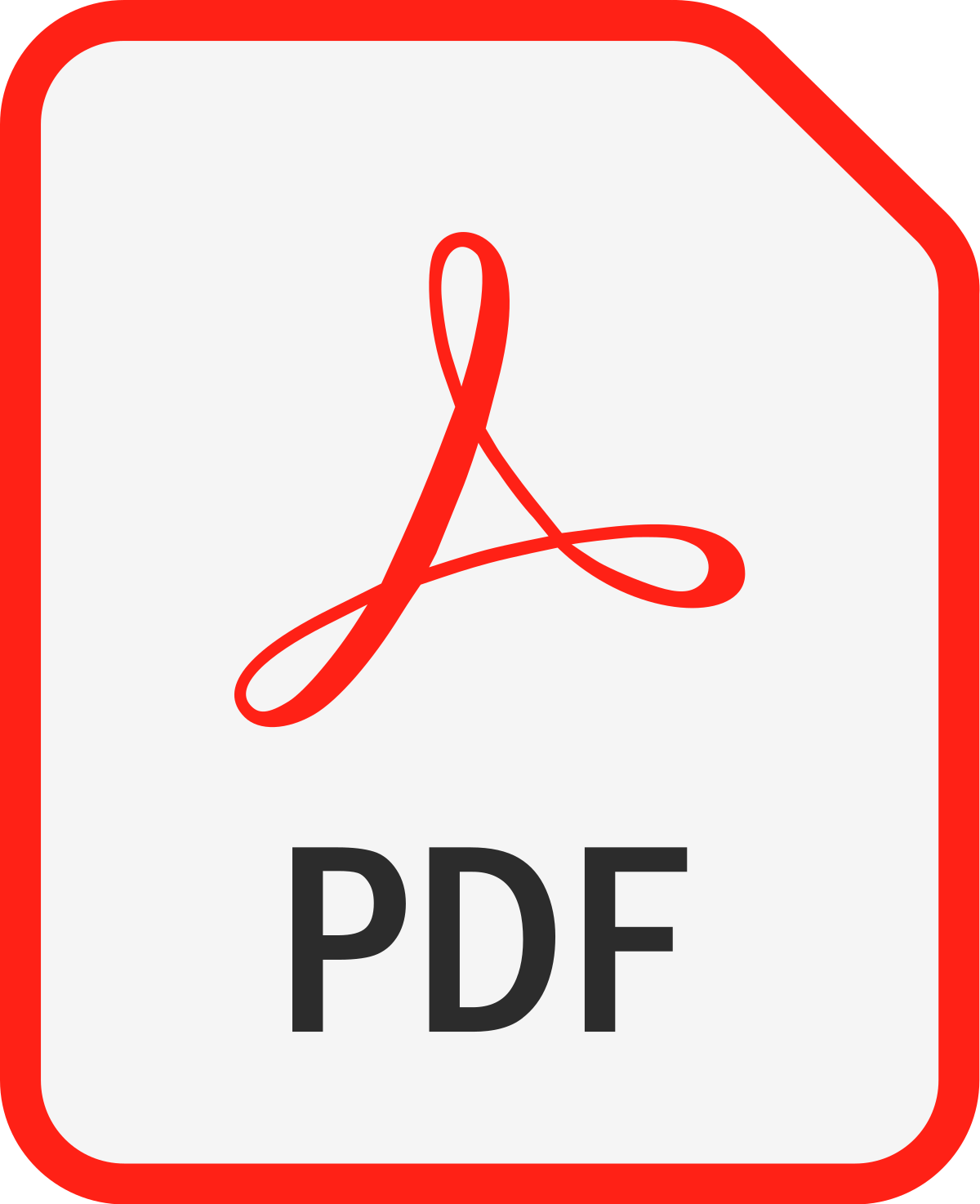
Pyrimisulfan Trials for Nutsedge Control in Bareroot Loblolly and Slash Pine Seedling Beds: A Second Year of Study
Nina Payne and Annakay Newell

Figure 1. Field layout of plots in pyrimisulfan (Vexis®) trials conducted by the SFNMC in 2022.
Table 1. Bareroot loblolly pine seedling characteristics treated with pyrimisulfan (Vexis®) at 7 weeks and 12 weeks post-sowing on June 14 and July 25, 2022, at PRT-IFCO White City, AL Nursery.
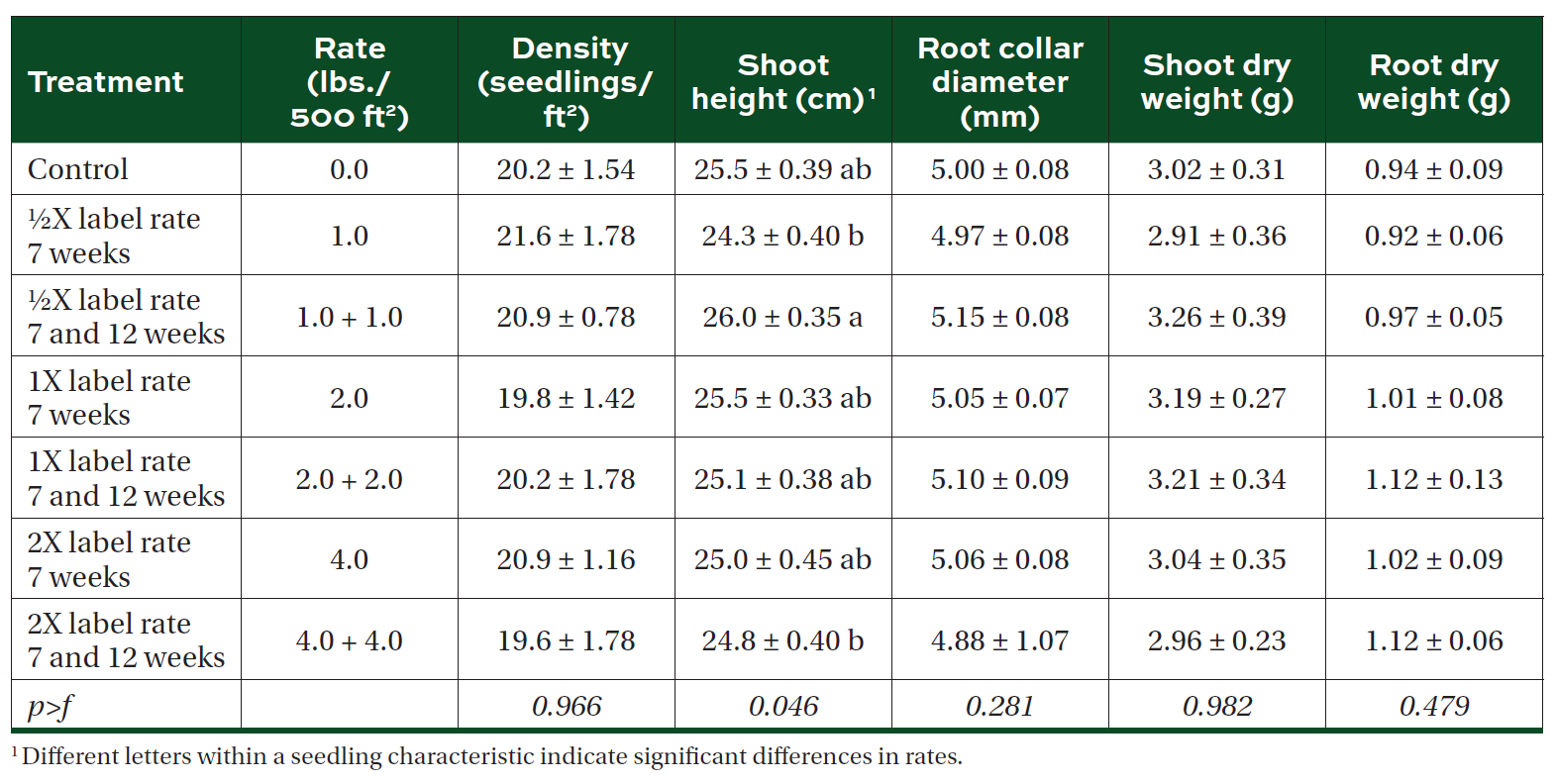
Table 2. Bareroot loblolly pine seedling characteristics treated with pyrimisulfan (Vexis®) at 7 weeks and 12 weeks post-sowing on June 17 and July 28, 2022, at PRT-IFCO Pine Hill, AL Nursery.
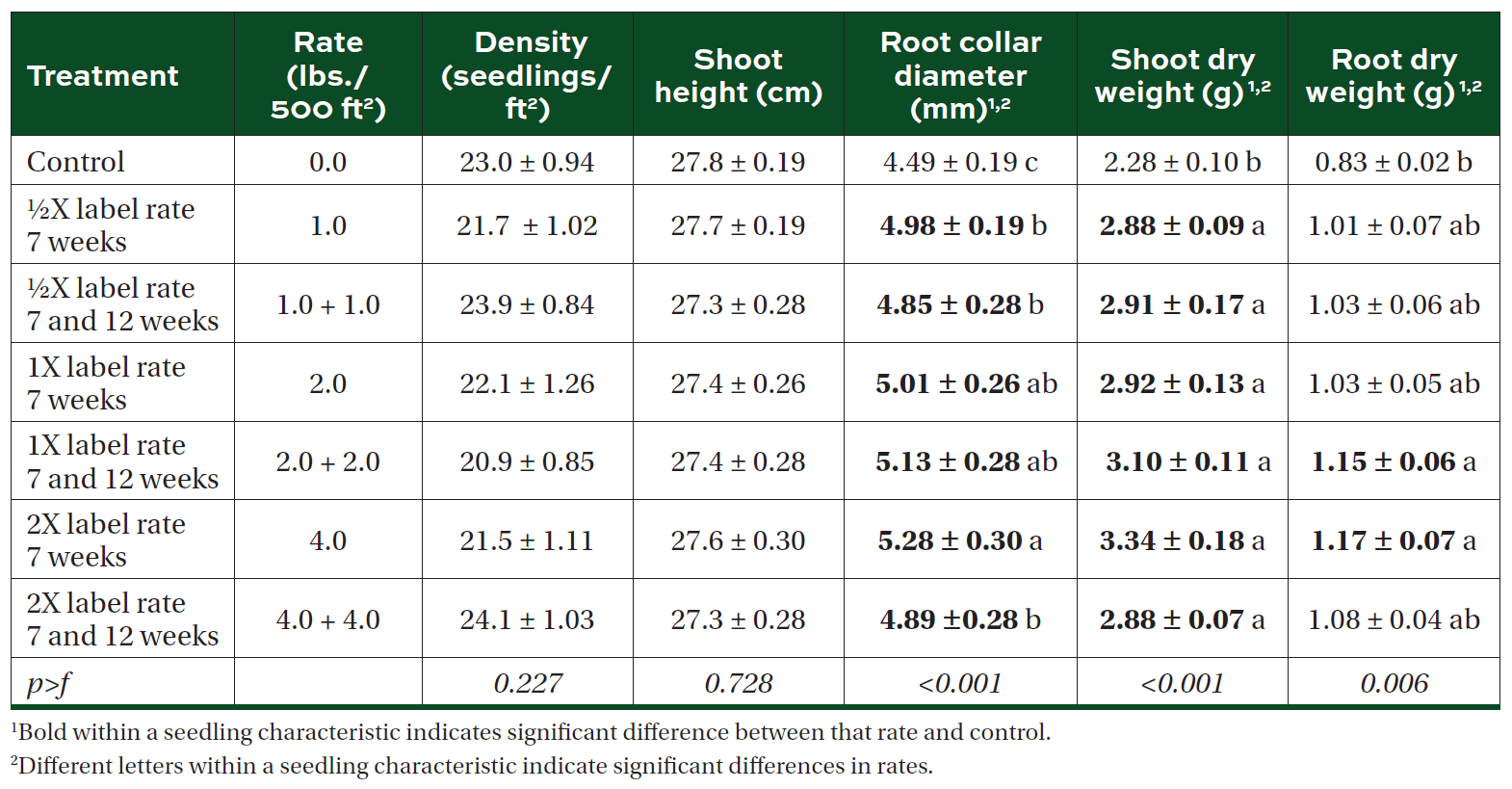
Table 3. Bareroot loblolly pine seedling characteristics treated with pyrimisulfan (Vexis®) at 7 weeks and 12 weeks post-sowing on June 21 and August 1, 2022, at Georgia Forestry Commission Flint River, GA Nursery.
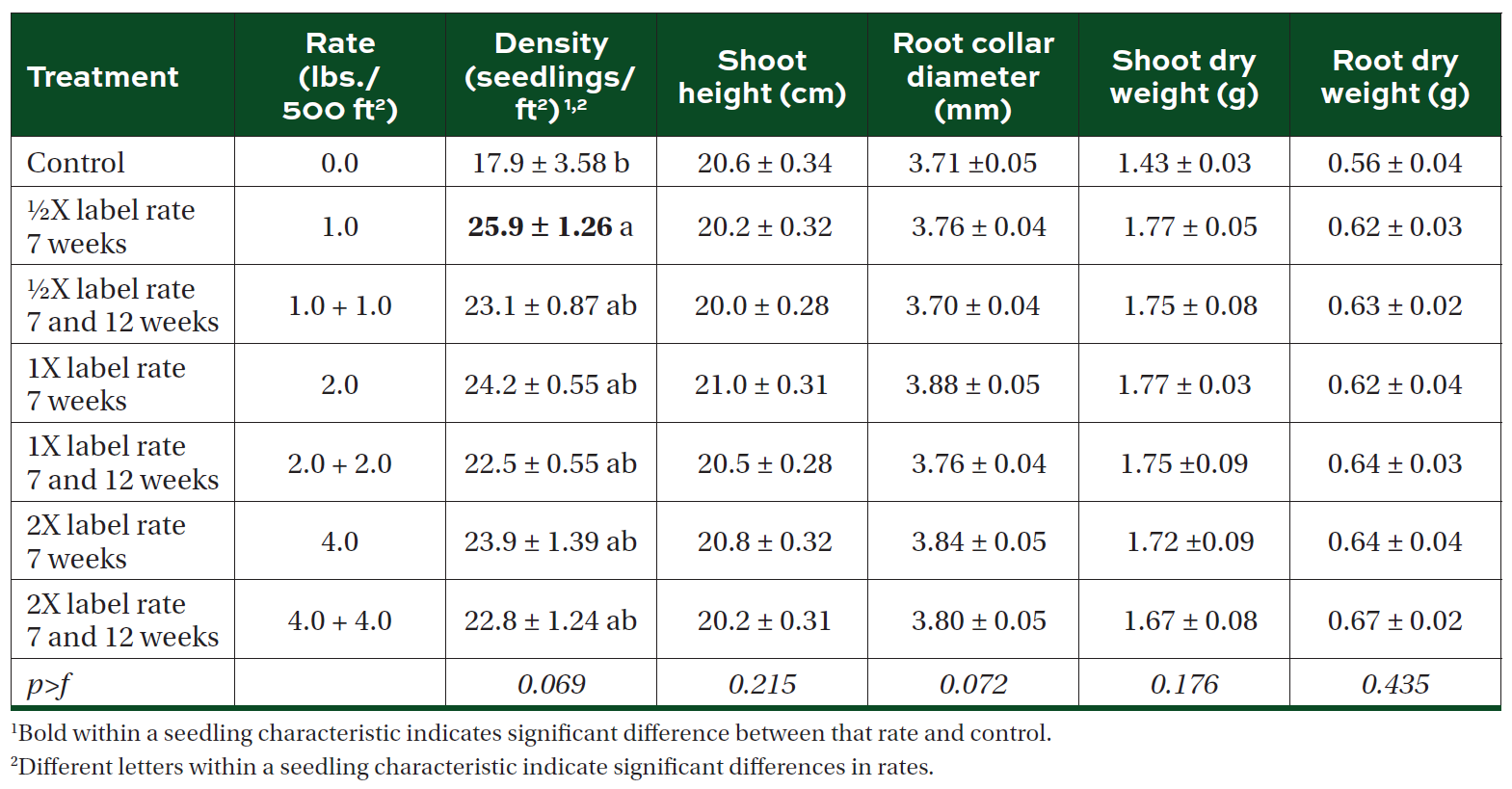
Table 4. Bareroot loblolly pine seedling characteristics treated with pyrimisulfan (Vexis®) at 7 weeks and 12 weeks post-sowing on June 24 and July 29, 2022, at Rayonier Elberta, AL Nursery.
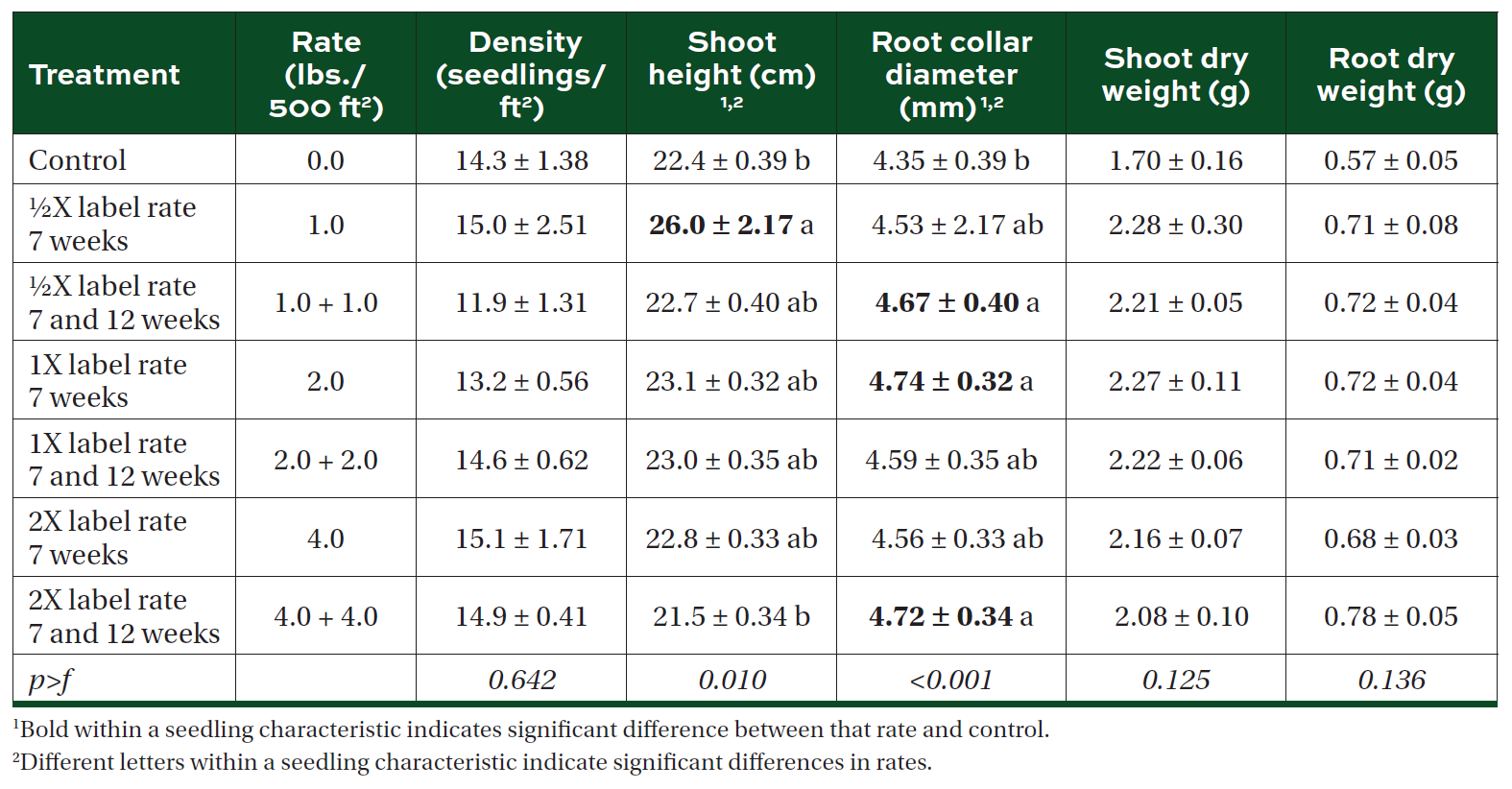
Table 5. Bareroot slash pine seedling characteristics treated with pyrimisulfan (Vexis®) at 7 weeks and 12 weeks post-sowing on June 17 and July 28, 2022, at PRT/IFCO Pine Hill, AL Nursery.
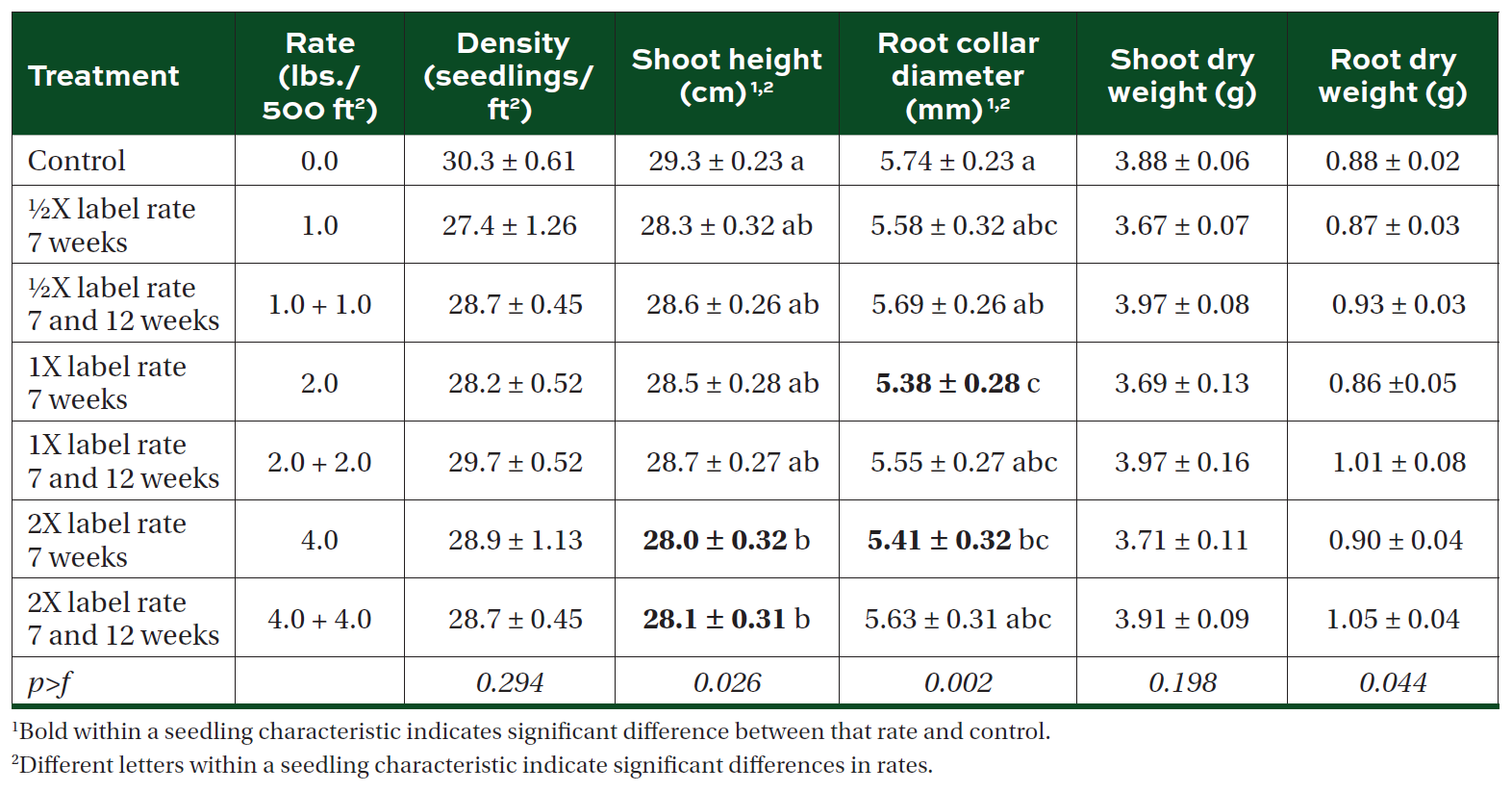
Table 6. Bareroot slash pine seedling characteristics treated with pyrimisulfan (Vexis®) at 7 weeks and 12 weeks post-sowing on June 21 and August 1, 2022, at Georgia Forestry Commission Flint River, GA Nursery.
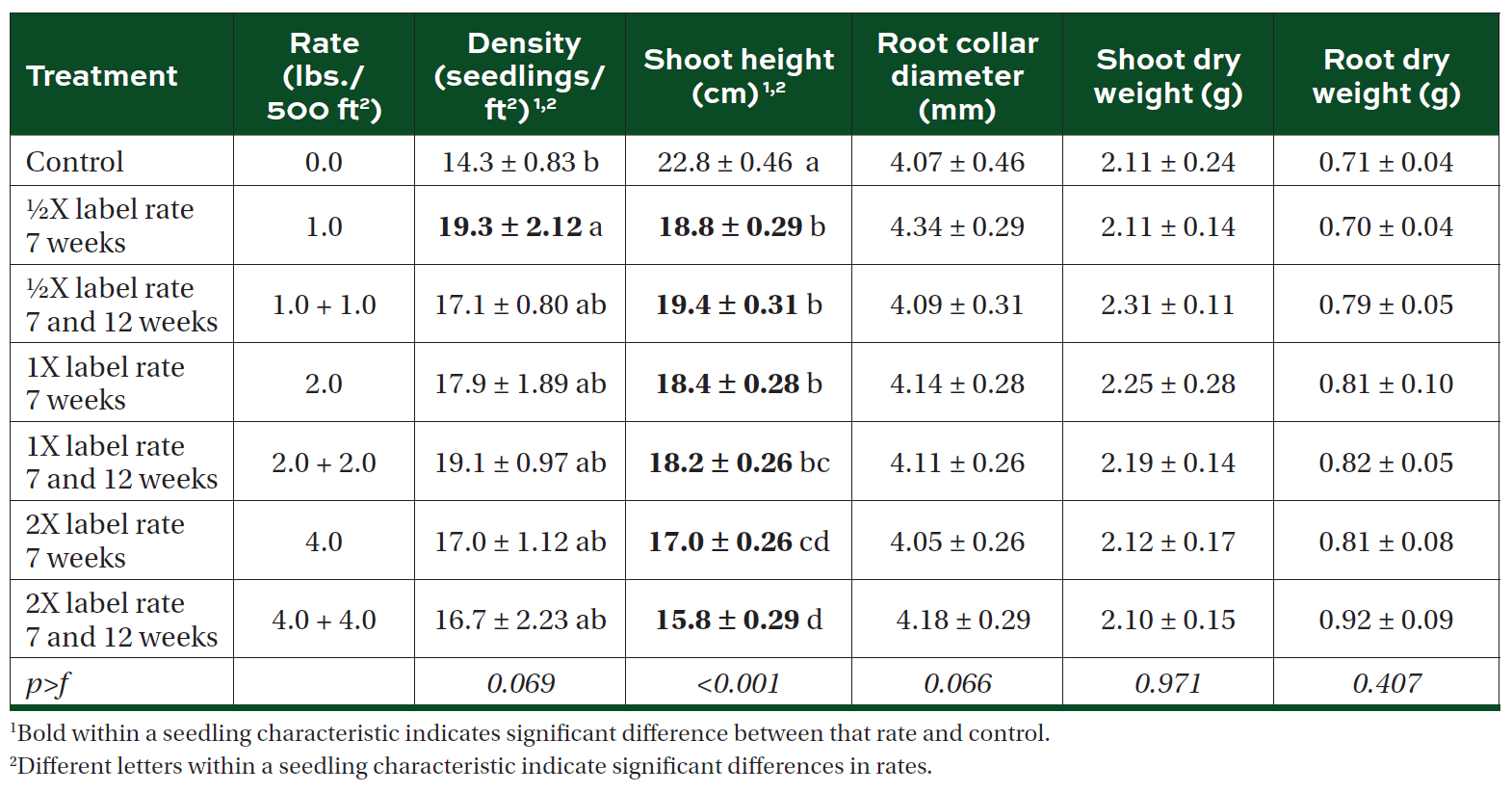
Table 7. Bareroot slash pine seedling characteristics treated with pyrimisulfan (Vexis®) at 7 weeks and 12 weeks post-sowing on June 24 and July 29, 2022, at Rayonier Elberta, AL Nursery.
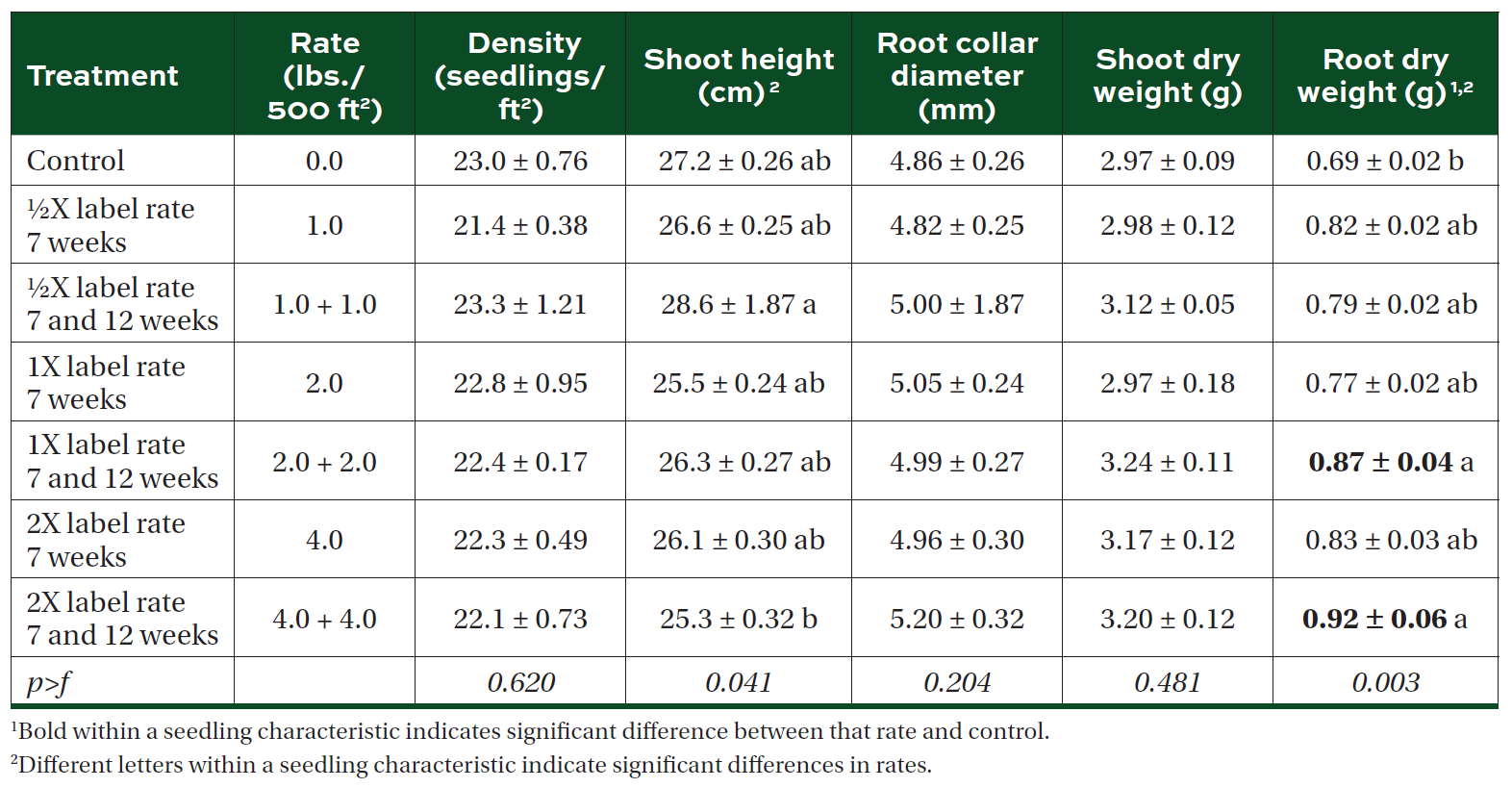
Introduction
The search for and testing of herbicides to control nutsedge in bareroot pine seedling beds has been an ongoing process for years in the southern U.S. The Southern Forest Nursery Management Cooperative (SFNMC) has played an active role in this process since 1975, with limited success. Bareroot seedling growers are still faced with infestations of nutsedge on a scale that often causes seedling production losses.
As part of its mission to provide testing of available chemical technologies for economical forest tree seedling production, the SFNMC installed trials in one bareroot seedling nursery in 2021 with a new herbicide product, Vexis®, targeting nutsedge. This herbicide is manufactured by PBI-Gordon Corporation, who brought its active ingredient, pyrimisulfan, to the U.S. market after its initial development in Japan. In late 2018, the EPA approved Vexis® Granular Herbicide for use in residential, ornamental, and institutional turf sites, commercial sod production areas, and other nonproduction sites including fencerows, roadsides, ditches, industrial sites, equipment storage areas, and utility rights-of-way. Conifer nurseries are not listed on the Vexis® label as an approved site of use. The Vexis® label list of controlled weeds includes nutsedge (purple, yellow, and annual), kylinga (green, false green, and cockscomb), path rush, and certain broadleaf weeds including chickweed, dollarweed, henbit, buttonweed, and wild onion and garlic.
Promising results of the initial pyrimisulfan trial in 2021 (SFNMC Research Report 22-03) led to the expansion of testing to four SFNMC member nurseries in 2022. These trials were designed to quantify tolerance of bareroot loblolly and slash pine seedlings to pyrimisulfan, as well as monitoring for nutsedge control in the beds used in the trials.
Methodology
In 2022, trial installations were designed with the intent of providing as much data as possible on pine seedling tolerance to the Vexis® manufacturer, within the capabilities of the SFNMC. At the recommendation of the PBI-Gordon Southeast Research Scientist, four nursery sites of varying soil types were selected for testing. These nurseries with their corresponding soil types, are listed below:
| Nursery | Soil Type |
|---|---|
| GA Forestry Commission Nursery Byromville, GA |
Eustis loamy sand, 0-2% slopes (0-68 inches loamy sand, 68-72 inches sand) |
| PRT-IFCO Pine Hill Nursery Pine Hill, AL |
Lenior silt loam, 0-2% slopes (0-2 inches silt loam, 2-6 inches loam, 6-2 inches clay loam, 12-80 inches clay) |
| PRT-IFCO White City Nursery Verbena, AL |
Blanton loamy sand, 0-5% slopes (0-42 inches loamy sand, 42-52 inches sandy loam, 52-65 inches sandy clay loam) |
| Rayonier Nursery Elberta, AL |
Wadley loamy sand, 0-5% slopes (0-6 inches loamy fine sand, 6-73 inches fine sand, 73-83 inches sandy loam) |
Loblolly and slash pine seedling beds were included in all nurseries with the exception of the PRT-IFCO White City Nursery with loblolly pine only included. The rates of Vexis® tested were the same used in the 2021 trial: ½ times the label rate, the label rate, and 2 times the label rate for turf applications (label rate is 2 pounds product per 500 square feet). Alterations to application timings were made for the 2022 trials, in an effort to predict and evaluate pyrimisulfan usage patterns in bareroot seedling beds. The initial application was made at 7 weeks post-sowing at each nursery, approximately 10 days earlier than in the 2021 study. This was done to provide earlier coverage of nutsedge control if needed. On one-half of the treatment plots, an additional treatment was made at 12 weeks post-sowing, with the intent of providing a second round of treatment if necessary. The herbicide was applied by hand by SFNMC staff, applying the product as evenly as possible within each plot in vertical and horizontal directions. Granules were watered in within 48 hours of application as recommended by the Vexis® label.
Treatment information is listed below:
| Treatment Number | Description | Rate/Timing |
|---|---|---|
| 1 | control | no treatment |
| 2 | 1/2X rate at 7 weeks | 1 lb/500 ft2 at 7 weeks post-sow |
| 3 | 1/2X rate at 7 weeks + 12 weeks | 1 lb/500 ft2 at 7 and 12 weeks post-sow |
| 4 | 1X rate at 7 weeks | 2 lb/500 ft2 at 7 weeks post-sow |
| 5 | 1X rate at 7 weeks + 12 weeks | 2 lb/500 ft2 at 7 and 12 weeks post-sow |
| 6 | 2X rate at 7 weeks | 4 lb/500 ft2 at 7 weeks post-sow |
| 7 | 2X rate at 7 weeks + 12 weeks | 4 lb/500 ft2 at 7 and 12 weeks post-sow |
The size of each treatment plot was five feet long by four feet wide (width of the seedling bed) while control plots were ten feet long. This extra length for control plots was planned with the anticipation that nutsedge growth in these may be excessive and encroach on adjacent plots. Prior to product applications, plots were measured and flagged for identification. A PVC pipe frame (4' X 5') was placed on each plot, and premeasured granular applications were made according to plot assignments. Five replications were used in all beds, for a total of 200 feet per seedling bed used. Plot layouts used are seen in Figure 1.
At the end of the growing season, seedling samples were collected from each plot in each installation. All seedlings within a 9-inch by 4-foot counting frame placed in each plot were lifted by hand, with outside rows' seedlings marked and separated from inside rows' seedlings. These were taken to the SFNMC laboratory in Auburn, Alabama for measurements. Notes of nutsedge populations in each plot were also made.
From each plot's samples, all seedlings were counted to quantify bed density. Twenty-five seedlings were then randomly selected from each plot's inside rows samples and measurements of shoot height, root collar diameter, shoot dry weight, and root dry weight were made. Data was analyzed using R Statistical Software (v4.1.2; R Core Team 2021) to identify significant differences between the means of each measured characteristic with Tukey's Honest Significant Difference (HSD) post hoc test. A significance level at alpha = 0.05 was used for comparisons.
Results
Loblolly pine: In all 4 bareroot loblolly pine installations, no negative effects of pyrimisulfan (applied as Vexis®) were identified in any seedling characteristic measured in any application. Several sites recorded mean heights, root collar diameters, and dry weights of shoots and roots of treated seedlings larger than those recorded from nontreated control seedling samples. This stands to reason by virtue of less nutsedge competition in the treated plots, allowing for more pine seedling growth. Data from loblolly pine installations are reported in Tables 1, 2, 3, and 4.
Slash pine: In the three installations of pyrimisulfan (applied as Vexis®) in slash pine seedling beds, no biologically significant negative effects of the herbicide were measured (Tables 5, 6, and 7). Treated seedling shoot heights were lower in two nurseries (Tables 5 and 6), measured at 1.2 centimeters to 7.0 centimeters shorter than seedlings from nontreated control plots. However, shoot height used as a measure of herbicidal effect is difficult to quantify, as seedling height is modified through the growing season by multiple passes of top clipping. Root collar diameters of treated seedlings in one nursery (Table 5) were smaller by 0.33 millimeters to 0.36 millimeters when compared to nontreated control sample seedlings. These quantities are biologically insignificant as they amount to less than 7% of the mean root collar diameters of those treatments.
Nutsedge: Visual inspections of trial installations over the growing season by staff at the 4 nurseries reported distinct differences in the amount of nutsedge and other weeds in plots. Nontreated control plots were easily identified by the large quantities of nutsedge present, and definite boundary lines between treated and nontreated plots were visible.
Management Implications
Results of trials in these 4 nurseries continue to provide data showing good loblolly and slash pine seedling tolerance to pyrimisulfan applied as Vexis®, even at higher-than-label rates, and in multiple applications. Excellent nutsedge control continues to be noted.
With the goal of adding conifer nurseries to the Vexis® label or to obtain 24-C labels in each state, a minimum of one additional year of multiple trials in bareroot pine nurseries should be conducted by the SFNMC. Contact and correspondence with the PBI-Gordon staff should be continued to stress the importance of labelling for conifer nurseries.
Acknowledgements
Our appreciation goes to the managers and staff of the Georgia Forestry Commission Nursery, PRT-IFCO’s Pine Hill and White City Nurseries, and Rayonier’s Elberta, Alabama Nursery for their field assistance and provision of bed space in these trials. Thanks also goes to Dr. Eric Reasor, Southeast Research Scientist, PBI-Gordon, for his guidance and recommendations on expansion of the 2021 trial and design of this 2022 trial, as well as providing product samples for SFNMC research use.
References
PBI-Gordon Corporation. Vexis® herbicide Granular label. Retrieved from: https://www.cdms.net/ldat/ldGAU003.pdf
Payne, N., T. Stokes, A. Newell, J. Fields, and R. Ayres. (2022). The efficacy of pyrimisulfan on nutsedge control and the tolerance of loblolly and slash pine in bareroot seedling beds. Auburn University, Southern Forest Nursery Management Cooperative. Research Report 22-03:6 pp.




